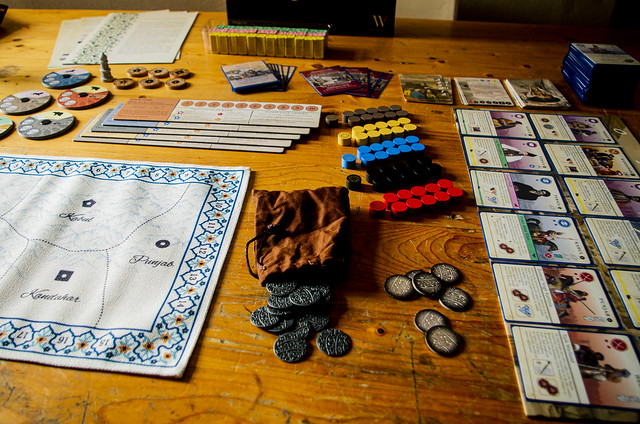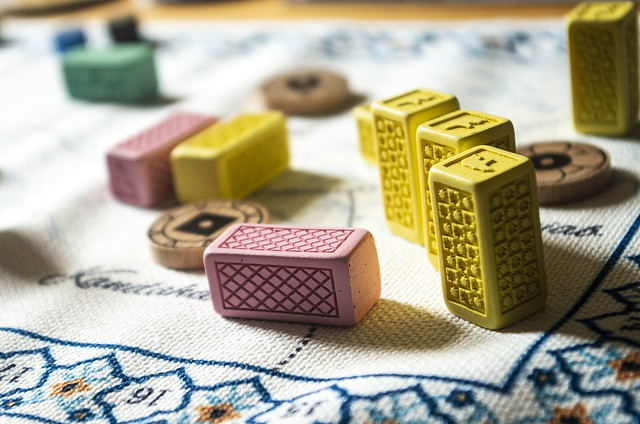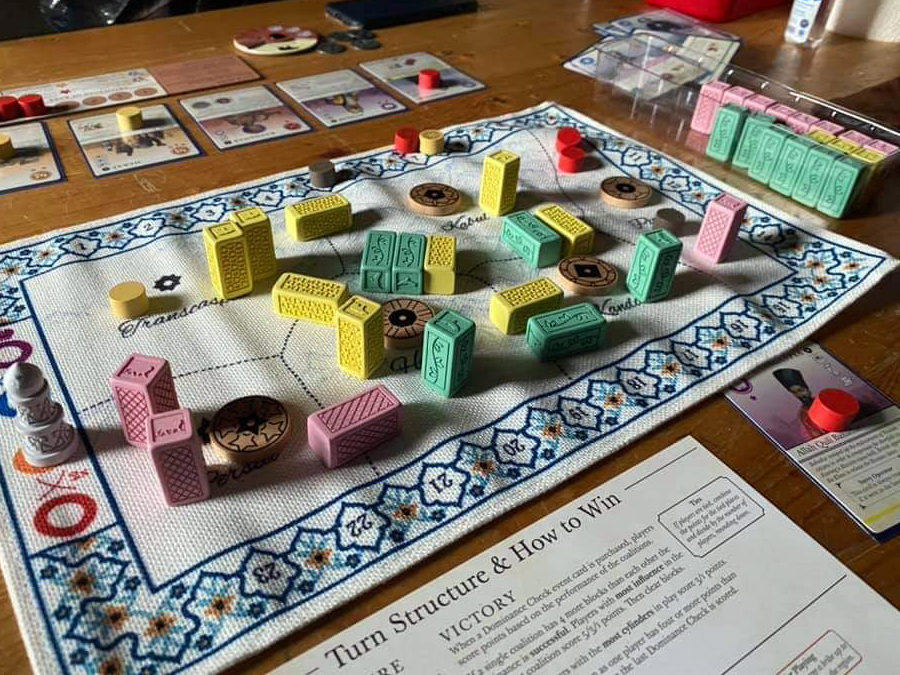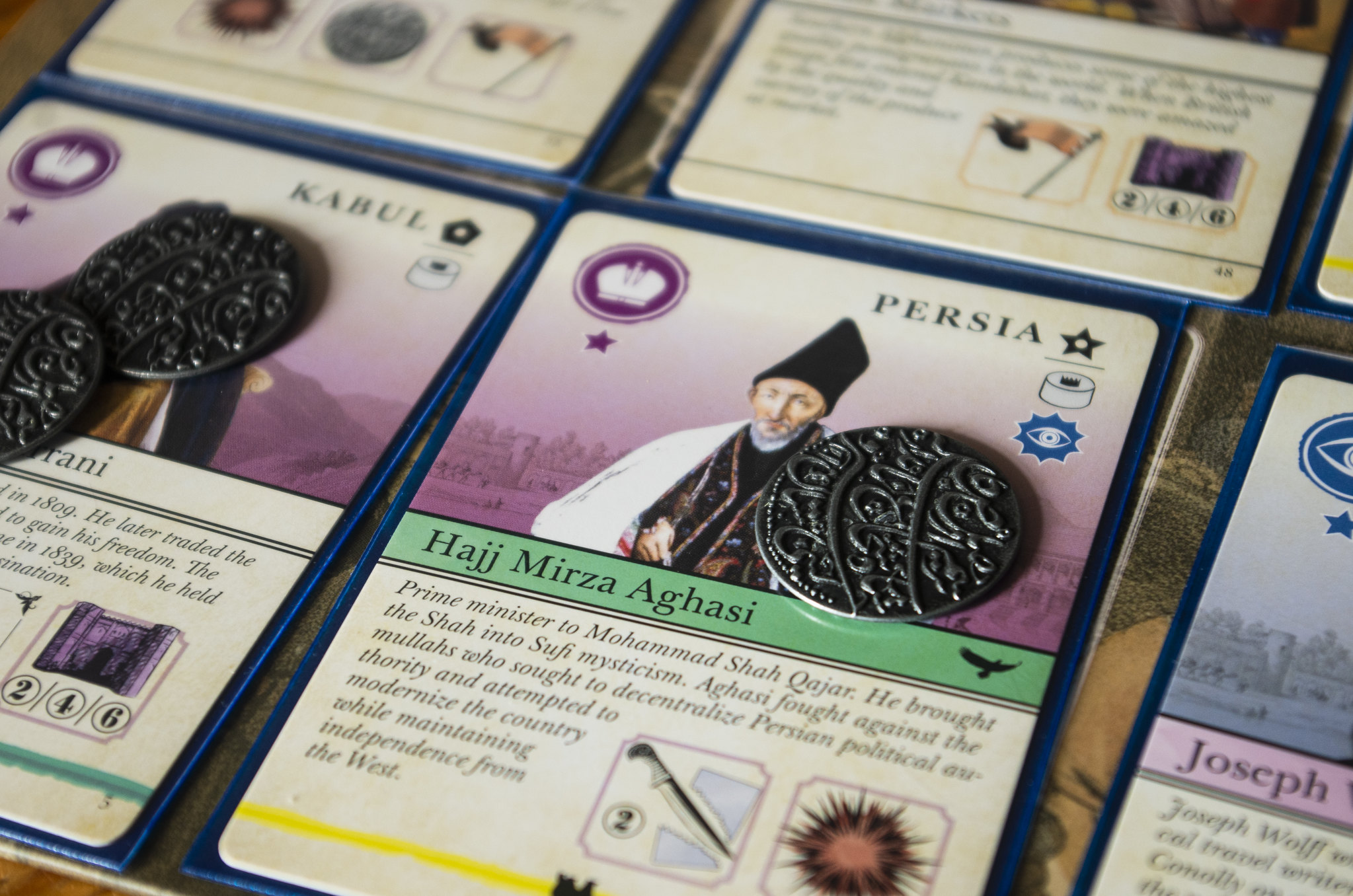In 1823 marked the fall of Durrani Empire. Stretching from the early Persia to modern-day Punjab, this monarch steered the power in Afghanistan during its peak. Sniffing the chance, Europe went in, led by British and Russian Empire. Consequently, they transformed the remnants of the then amazing realm to their fighting ground. This concludes the history of The Great Game, the background story adapted by Cole Wehrle to be the plot in Pax Pamir. He is also the mastermind behind Root, if you have tried the game.
Pax Pamir’s first edition came out in 2015. It was distributed by Sierra Madre Games, a publisher well-known for their design in board games integrated with unusual themes. Adapted from Phil Eklund’s fundamental mechanic in his long-reigning games (officially the Pax series, starting with Pax Porfiriana’s release in 2012), Cole Wehrle developed Pax Pamir with Sierra Madre Games and released an expansion, Khyber Knives.
My article today is focused on the second edition, a grand rework by the very Cole Wehrle from its first edition. Under his company with Drew Wehrle, Wehrlegig, Pax Pamir 2nd edition is successfully funded in Kickstarter.

The components of Pax Pamir, giving that chilling table presence.
There are three primary coalitions in Pax Pamir. The British, Russian, and the Afghan. We will not take role as one of these unions, but instead as the Afghan tribe leader, trying to grasp power and be loyal to one of the superpowers in Afghanistan’s warring era. Building networks, deploying troops and spies, these leaders will blatantly eradicate or plot to backstab each other. The aim of the game is to be the most loyal to the coalition in…
…power, at any price, even by selling out our allies.
The game mechanic, or several ways to shake Afghanistan
Explaining how to play Pax Pamir with its delicate details and specific without any visual and dynamic components proves to be a labour of Hercules. Nonetheless, I’m giving my best effort to give an overview that makes Pax Pamir an interesting game.
In the beginning of the game, each of us takes turns to pledge loyalty to one of the coalitions. During his/her turn, a player takes two actions; the action is limited to either purchasing cards or playing cards from hands in the opening of the game. We get four coins, the currency in Pax Pamir to do any kind of transaction, such as acquiring a card, paying an action’s cost. Instead of going to the common pool, the coins we pay…

Three Russian armies are ready to obliterate the roads built by the British.
…with are paid to the market (something that you find in Century Spice Road). With that in mind, this game has a tight economy aspect, because there’s only one way how the coins come back to the game.

The map of Afghanistan is simplified and printed abstract only with its six primary regions. This map is not the sole playground for the games of power. The conflict stretches to each of our tableau, as Pax Pamir also associates it as another location. With connecting cards coming into the equation, the whole tableau from all players becomes a huge arena. When playing a card, we can choose to place it on the left or right side. Afterwards, it is no longer possible to rearrange the cards’ position. Your strongest allies’ position must be considered well if you don’t want to end up killed by the other party’s spies. These cards are not mere information slates, they become actors and actresses in The Great Game, where they kill, get killed, and cross others without mercy.
In short, Pax Pamir is a tableau building game with specific actions printed on each card to give additional options for us while playing. All players start with equal capital and power, but the game becomes more asymmetric when the engine is built. There are four card variants (politic, economy, intelligence, and military) with up to three from six available actions below:

This photo is taken by Ronald Masrin.
- Build. This is an action to assemble military power or build networks based on the loyalty pledged to the coalition.
- Tax. By performing this, players can take back the coins, be it from the market or from other players.
- Gift. To increase loyalty, one must present a gift to the ruler.
- Move. We can move spies or armies to prepare assassinations or just to find the most strategic position.
- Betray. This is one of the most amusing actions to perform. We kill allies (or cards) with spies.
- Battle. Another action involving spies and armies. There is no die available to mitigate the result. If there’s a will (and power), there’s a way. All assassination attempts will bring result.
All of these six actions are the main core for our engine, which combinations depend on the market and short-term plans we have. In addition, an Impact Symbol is printed on each card, the supplementary action triggered whenever this card is played to the tableau. The additional actions include building networks, sending troops and spies, changing Afghanistan’s states of affairs, adding coins back from the bank to the gameplay, and spawning tribes in one out of six locations on the map. The decision-making on which card to play is not limited only to how to build a good engine but it stretches also to how to change the gaming state.
The amalgam of both engine building and changing the game flow based on the most rewarding chance is the main focus of Pax Pamir. We have to be aware of all elements in the game. They are all playing important roles in securing your spot. Otherwise, something bad may happen and you do not want it. For example, if you are not careful, your ally may get killed mercilessly.

Hajj Mirza Aghasi was the Sadr-e Azam, or equivalent to the prime minister position between 1834-1848.
There are up to four scoring events, which are triggered by drawing a specific card in the market. In this phase, players look at the dominant coalition and the most loyal among them. If there is no dominant coalition, then the player with the most components on the map and the cards will score. If one player has four points more than the others, the game ends. Otherwise, the game continues until four specific cards are drawn and four scoring events take place. The player with the most points wins the game and becomes the ruler of Afghanistan.
Becoming opportunistic in this political playground
I’ve mentioned above that each player will try to convene a coalition with one of the three main powers in that era. However, I’ve not broached one thing that makes Pax Pamir extraordinary yet. When the scoring card is drawn in the market, the scoring phase is not commenced at once. The card is merely an indicator that the scoring happens in the next few turns. With this in mind, each of us still has the opportunity to change the coalition, taking the side that is the most advantageous.
There are two ways to switch allegiance, and one of them involves eliminating an ally (sending a spy to kill a card by using Betray action) prized by the coalition you want to pledge your new loyalty to. You may kill the ally on your tableau, if you want to, when needed. Another way is to play a Patriot card (a special card with banners from three coalitions). Thematically, it depicts a betrayal against your former coalition while you’re building the new relation with the new one, which is deemed more beneficial for you. This switch happens frequently in Pax Pamir, forcing you to adapt to changing situations by becoming cunning and deceitful.

Once again, it is a labour of Hercules to explain all the rules of Pax Pamir without its component and dynamic visual. Even so, with them will still not be an easy task to teach others due to its rule and unusual theme. Without pretending to be cute like its predecessor Root, Pax Pamir is courageously bringing up the complex background story with its unconventional components. They successfully depict the nuance in the convoluted subject. If you go extra miles to crunch on the mechanic and the theme, each session tells you unique tales, each phase and round will be intense without random elements and dice for conflict resolutions.
Pax Pamir 2nd Ed. is a gate to Afghanistan’s history; a tableau-builder, area control, and conflict simulation in one compact box
Unlike other tableau builders that start from puny state and progressively gain power until the end of the game, Pax Pamir is more than that. In this game, we try to be as efficient as possible to build our engine for each round. We have to swiftly adapt and change the engine to respond to the shifting conditions during the game.
Pax Pamir has different characteristics in comparison to area control games in the market currently. While the other games have a firm and fixed game flow, this one is more tactical. It demands the player to be more opportunistic, to read the best time to build power. In the end, we have to be sharp when deciding who gets to be allies and enemies.
While other war games demand players to get familiar with the historical events happening in the background story, Pax Pamir happens to teach players about it. With the unique experiences from the gameplay, this game rewards those who want to understand the context of the lore that’s full of politics, espionage, and unscrupulous power struggles.

However, Pax Pamir is not for you who loves to devise long-term plans and reap many Victory Points (VP) at the end of the game. This game is more likely enjoyable for players that like to explore, experimenting strategy, changing things when the situation is out of hand. Knowing your way is no more efficient and changing it swiftly is one of the best ways to play Pax Pamir.
Pax Pamir may not be for those who have no love for randomness and uncertainty. It fits perfectly in your collection, if you like spontaneous circumstances and playing with probabilities.
If you are more a Zen player who dislikes tackles, lies, and other kinds of negative interactions, once again Pax Pamir is not your game. This game is more suitable for others who like deception, trying to find the gap and crack to win the game.
For me, Pax Pamir is an epitome of perfection; with components that serve up a feast for the eyes, its high replay value, and variation in each gaming session. In addition, the flexibility in the player count is the real deal, it’s not only an empty marketing jargon on the box, trying to lure buyers with it.
Pax Pamir is a one-and-only game with a mechanic that involves players to the depth of contextual level from the theme it brings. This could be the best gate to another Pax series, or another option for your direction-interaction game besides Blood Rage or Rising Sun.
You can always contact me via Facebook if you are interested in playing Pax Pamir online.
Pictures & text: Aditya H. Martodiharjo
Editor & translator: Stephan Celebesario Sonny





